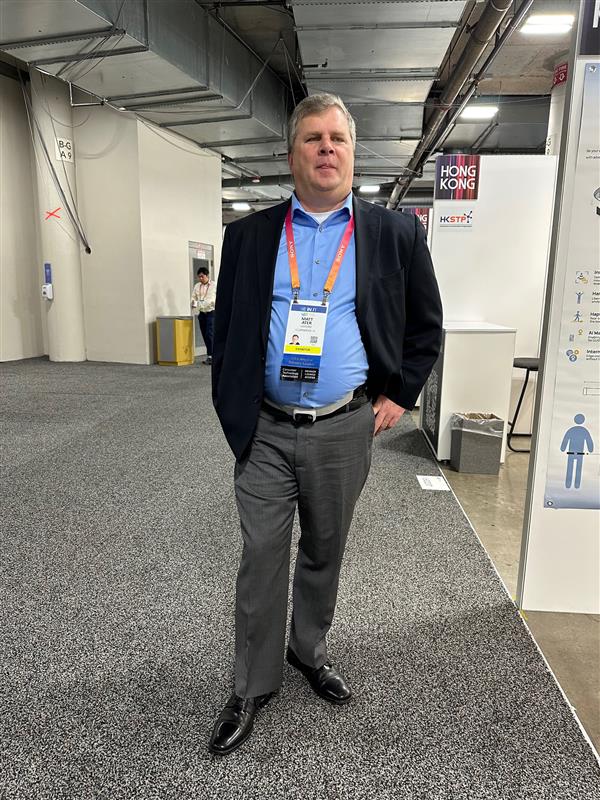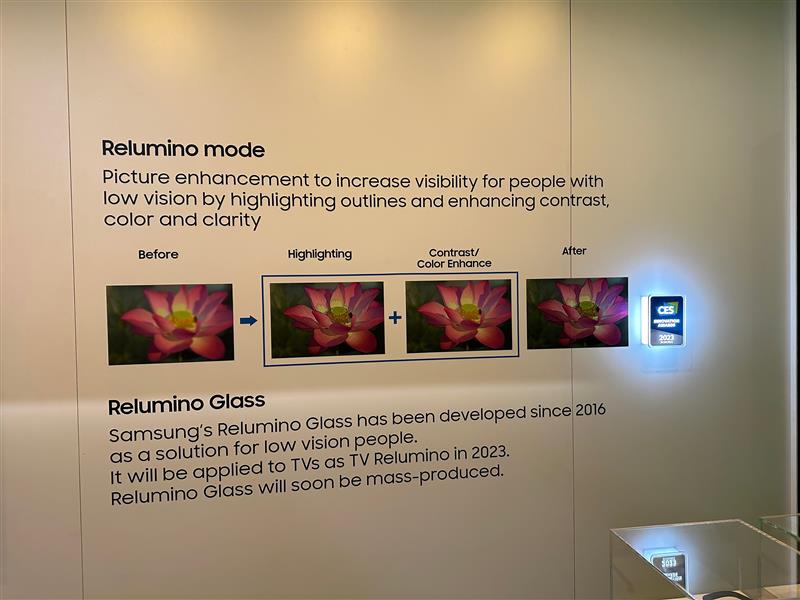This content originally appeared on TPGi and was authored by Matt Ater
Each year, January brings the biggest show in technology to Las Vegas. I started going to the Consumer Electronics Show (CES) in 2015, looking to see how technology could enhance the lives of people with disabilities. Seven years later, I still enjoy checking out the latest fads, cool new gadgets, and just wild ideas. From drones to smart homes, from closets that fold your clothes to transformer robots, CES will show you both stuff that will never launch to stuff that will be in every store in the future.

For me, the show always begins with the Accessibility Roundtable, this year sponsored by MITRE and Ricoh. This is where advocacy groups, like the American Printing House for the Blind or National Black Deaf Advocates come together to talk with technology companies like VOXX International or Dolby Laboratories.
The roundtable started with the Consumer Technology Association (CTA), which puts on the conference, discussing two regulations. The first being the FDA’s recent decision to change previous regulations and allow hearing aids for mild to moderate hearing loss to be sold over the counter. The second being Tammy Duckworth’s proposed “Websites and Software Applications Accessibility Act,” which, if passed would establish that websites are included under the ADA and so need to be accessible. Overall, we discussed over the counter hearing aids more than any other topic.
Not only did discussing this take up an entire segment of the meeting, but many vendors throughout CES were showing off over-the-counter hearing aids, such as Nuheara, who also participated in the accessibility roundtable. The roundtable discussed other topics, like the pros and cons of various corporate accessibility structures (such as creating a Chief Accessibility Officer or fitting accessibility into an existing department). Following the roundtable, we all migrated to a reception to network in a less structured environment. After mingling, I attended the keynote by Advanced Micro Devices (AMD) CEO Lisa Su who discussed the centrality of semiconductors in modern life and the growing power of AI. She also showed off new, more complex processors created by AMB.
My day two began with moderating a panel called AI in Accessibility. All four people on the panel, including me, worked in accessible technology. AI can seem Sci-fi and abstract, but we spent the panel discussing the down-to-earth impacts of AI for people with disabilities. One of our panelists, Michele Lee, works at Cruise, a self-driving car company, and she explained that self-driving cars use AI and that these cars can make it possible for wheelchair users who can’t drive currently to get places independently in the future. She uses a wheelchair, and she explained how now she has to coordinate rides with her family and can only get certain ride-shares but all that would change with a self-driving car. Sasha Blair-Goldensohn, a panelist from Google, told the audience about an innovation in Google Maps. Blair-Goldensohn also uses a wheelchair, and that before in Google Maps he could get directions to the restaurant but be unable to get inside because it had stairs with no ramp or find that the bathroom is inaccessible. The directions were the “same for everyone” but not “making it actually work for everyone.” Now there is an opt-in feature that marks wheelchair accessible buildings in Google Maps and hopes of making this a default icon. Another panelist, Michael Williston, explained how all speech to text technology uses AI. This underlies his product, Badger, which I’ll tell you more about later. As moderator, I pointed out that AI is starting to become more reliable at identifying objects and explained how this can be extremely helpful for people who are blind.
After the panel, I walked around the conference. It’s a massive space, with almost 2.2 million net square feet of exhibits run by more than 3,200 exhibitors. Some booths are massive – John Deere’s was big enough to fit a huge tractor tire—while others are smaller. For instance, the booths in Eureka Park are averaged sized. I walked around the building and came across a lot that impressed me so I’ll highlight some of the new assistive technologies that I encountered:
One of the things I saw was called Relumino, an app from Samsung that uses AI to outline images then amp up the contrast, brightness, color, and sharpness. This will help those with low vision discern objects and people in lower-contrast images.

I also checked out VoiceGo from a company called Mighty Vision. It’s a pair of bone conduction headphones with a camera and mic built in. The hardware doesn’t have software yet, but the idea is that the product could read text, like a menu or an instructional sign, that the camera sees out loud. This is similar to what products like OrCam and Envision do today, but the real benefit of VoiceGo is the form factor. Those other products are glasses, but the fact that VoiceGo is simply a pair of headphones means that you get to skip on the downsides of glasses, such as, if a person has low vision, the glasses could interfere and make it harder for them to see. Let’s see if VoiceGo makes it to market.
Seleste has created a similar product, one that’s paired with Seeing AI and is a pair of glasses with a camera attached. This product was further along on software than VoiceGo and had the ability to use OCR (Optical Character Recognition) to convert text to speech on the fly.
One of the things I noticed this year is that there are many companies trying to create a product that can detect objects so people who are blind can maneuver around objects easier and don’t run the risk of running into them. Most of these companies were found in Eureka Park. Biped is one example. I saw this shoulder harness at CES last year and since then, they have made improvements to the sounds that are used to notify users that an object is in their path.
Lighthouse Tech is another company that’s focusing on this issue. The difference is that their product is a pair of glasses with haptic technology. The advantage of glasses comes from placement. A white cane can only detect obstacles from the waist and below; glasses can detect obstacles near your face, like tree limbs or cabinet doors. In this case, haptic technology is a way of giving directions through vibrations, such as vibrating in the front to signal that an object is in front of the user, to the side to signal that an object is to the side etc. This product works similarly to Biped’s.
A Hong Kong startup had a table where people could check out their solution, a belt that used haptic technology to notify you which way to turn in order to go around objects. Though I did not see them myself, I also heard there was a startup in Panasonic’s booth also looking to solve the problems of object detection with a pair of “steam-punk-looking glasses.” As a person who has ran into my share of tree branches, I applaud the focus and hope that the companies seek out feedback from people who are blind or have low vision.
CTA Foundation Awards
As the Chairman of the CTA Foundation, I would be remiss for not sharing that the Foundation Awarded our five Eureka Park Winners.
These pieces of technology enhance the lives of older adults or people with disabilities:
- Badger – A badge that creates captions for live speech in real time
- Biomotum – A robotic shell that straps around the leg and assists with walking
- Kalogon – A computer-assisted cushion that relieves pain, improves posture and increases blood flow for wheelchair users
- Strap Tech – A sensor on the chest that detects obstacles and uses haptics to alert the user about the type of obstacle, position, and distance
- Xander – These glasses show live captions for anyone talking
CTA Foundation Pitch Competition
The CTA Foundation Pitch Competition is awarded to “startups with technologies that help people of all ages and abilities get out into the world, whether for work or play.
- Grand prize: GoodMaps – Indoor navigation that works with a 3D map of the space created with lidar
- Second prize: ReBokah – An app designed to assist people with low vision that has adjustable camera filters that control color, contrast, zoom, etc
- Audience choice: Xander – These glasses show live captions for anyone talking
Other Notable Innovative Assistive Technologies from CES
- The Labrador Retriever Robot – A cube shaped robot that can assist with independent living by transporting items around the house
- The Power Wheelchair Bro – A wheelchair that can climb up stairs
CES brings a lot of buzz to start each year. It also brings needed rest. 30,000 steps a day, events each evening and constant noise will have you ready to be home reading a book. As I was kicking back and resting, I looked forward to seeing which of these products make it to the market. Will I be wearing something next year at CES that will identify people and objects while walking the floor of CES? It will be exciting to find out.
The post My Experience at CES 2023 appeared first on TPGi.
This content originally appeared on TPGi and was authored by Matt Ater
Matt Ater | Sciencx (2023-02-17T21:55:30+00:00) My Experience at CES 2023. Retrieved from https://www.scien.cx/2023/02/17/my-experience-at-ces-2023/
Please log in to upload a file.
There are no updates yet.
Click the Upload button above to add an update.
